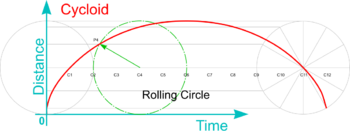Cycloid: Difference between revisions
From DT Online
mNo edit summary |
(Changed Image) |
||
| Line 13: | Line 13: | ||
* Repeat this procedure for each progressive centre position as shown. | * Repeat this procedure for each progressive centre position as shown. | ||
* Sketch a fair curve through the points ''(or use [https://en.wikipedia.org/wiki/French_curve '''French Curves'''] or a [https://en.wikipedia.org/wiki/Flat_spline '''flexible strip'''] for example)''.</span> | * Sketch a fair curve through the points ''(or use [https://en.wikipedia.org/wiki/French_curve '''French Curves'''] or a [https://en.wikipedia.org/wiki/Flat_spline '''flexible strip'''] for example)''.</span> | ||
| [[ File: | | [[ File:CycloidConstruction.png|350px|right]] | ||
|} | |} | ||
---- | ---- | ||
Revision as of 16:54, 21 February 2015
An Cycloid is the path traced by a point on the circumference of a circle as it rolls without slipping along a straight line. The curve has been used to design gear teeth and has sometimes been used by architects to design the shape of a curved roof. The term ‘cycloid’ is used also to describe the shape of some fish scales.
A line produced by a point following a set of rules in this way is known as the locus of a point (plural is [ [loci]]).
| Drawing a Cycloid |
|
Note: The cycloid is a special case of Trochoid in which the point traced is on the circumference of the rolling circle. Using a similar technique, Superior and Inferior Trochoids can also be generated by plotting points either outside (as the tip of a paddle wheel as a boat is propelled by it) or inside the rolling circle (as if marked on a rolling disc for example) . Also, by similar trechniques, the base line can be replaced by a base circle and the rolling circle rolled around either the inside or the outside of it to generate Hypocycloids or Epicycloids - as used in Epicyclic Gearing for example ,
